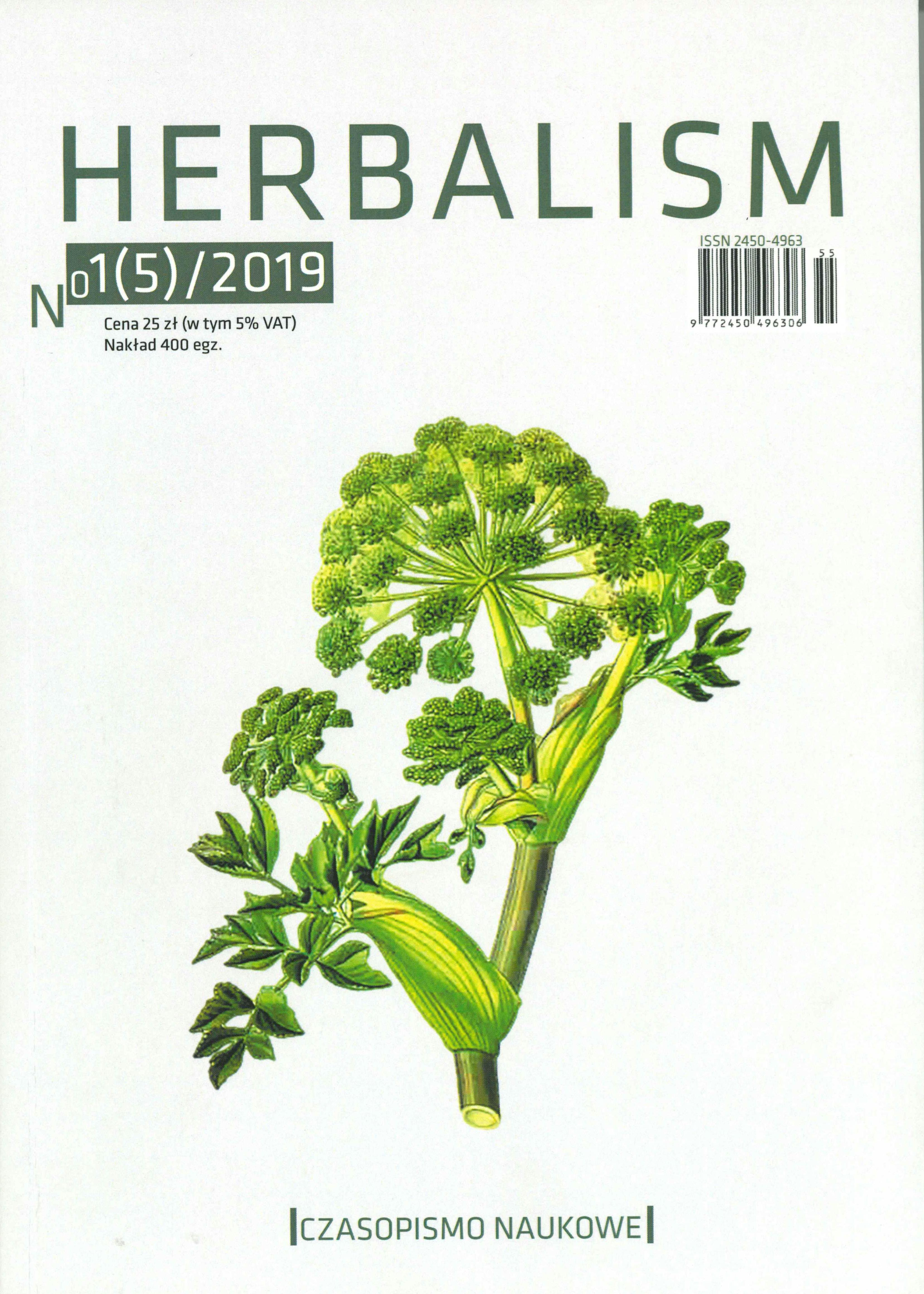Rola substancji roślinnych w procesie odchudzania
Ključne reči
nadwaga, zioła, dietaApstrakt
Nadwaga oraz otyłość stanowią obecnie jedno z największych zagrożeń dla populacji ludzkiej w Polsce i na świecie. Według ostatnich danych – z dnia 15 marca 2017 roku opublikowanych przez Biuro Analiz Sejmowych – osoby z nadwagą stanowiły w Polsce 36,6% społeczeństwa, a osoby otyłe 16,7%. Było to powyżej średniej dla krajów Unii Europejskiej, w której te wartości wynoszą odpowiednio 34,8% i 15,4%. Główną przyczyną otyłości jest zły styl życia. Składa się na niego zbyt mała aktywność fiyczna oraz spożywanie zbyt dużej ilości łatwych do przyswojenia węglowodanów. Nie ma cudownego leku, którego zażycie spowoduje zmniejszenie masy ciała,
ale naturalne substancje roślinne mogą w tym pomóc. Zioła, takie jak liść morwy, czy ziele pokrzywy mogą poprzez zahamowanie alfa-glukozydaz wydłużyć proces wchłaniania się cukrów prostych ze światła jelita do krwi. Błonnik, m.in. przyspiesza pasaż jelitowy, zwalnia wchłanianie się lipidów i węglowodanów oraz działa prebiotycznie. Na masę ciała wpływ ma również właściwy stan emocjonalny. Dlatego surowce o działaniu uspokajającym, takie jak korzeń kozłka, szyszki chmielu, liść melisy i poprawiające nastrój ziele dziurawca mogą mieć pozytywny wpływ na
redukcję masy ciała. W przypadku nadwagi stosuje się także substancje przyśpieszające metabolizm, takie jak Garcinia cambogia oraz substancje kofeinowe, takie jak nasiona guarany.
Reference
Zgliczyński W., Nadwaga i otyłość w Polsce, Infos, 2017, 4(227), s. 1–4.
www.ewadabrowska.pl
Żak-Gołąb A., Olszanecka-Glinianowicz M., Kocełak P., Chudek J., e role of gutmicrobiota in the pathogenesis of obesity, Advances in Hygiene and Experimental Medicine, 2014, 68, s. 84–90.
Estruch R., Ros E., Salas-Salvadó J., Covas M.I., Corella D., Arós F., Primary Prevention of Cardiovascular Disease with a Mediterranean Diet, e New England Journal of Medicine, 2013, 368(14), s. 1279–1290.
Zhao G., Etherton T.D., Martin K.R., West S.G., Gillies P.J., Kris-Etherton P.M., Dietary α-Linolenic Acid Reduces Inammatory and Lipid Cardiovascular Risk Factors in Hypercholesterolemic Men and Women, Journal of Nutrition, 2004, 134(11), s. 2991–2997.
Vander Wal J., Gupta A., Khosla P., Dhurandhar N.V., Egg breakfast enhances weight loss, International Journal of Obesity, 2008, 32, s. 1545–1551.
Jarosz M., Suplementy diety a zdrowie, Wydawnictwo Lekarskie PZWL, 2008, s. 75–76.
Lamer-Zarawska E., Kowal-Gierczak B., Niedworok J., Fitoterapia i leki roślinne, Wydawnictwo Lekarskie PZWL, 2007, s. 39–40.
Ionesco-Tirgoviste C., Popa E., Mirodon Z., Simionescu M., Mincu I., e eect of plant mixture on the metabolic equilibrium in patients with type-2 diabets mellitus, Revista de MedicinaInterna, Neurologe, Psihiatrie, Neurochirurgie, Dermato-venerologie. Medicina Interna, 1989, 41(2), s. 185–192.
Malczyk E., Maciejewicz M., Znaczenie toterapii przy wspomaganiu leczenia otyłości, Hygeia Public Health, 2017, 52(3), s. 209–216.
Walkiewicz K., Nasiek-Palka A., Gętek M., Muc-Wierzgoń M., Kokot T., Klakla K., Nowakowska-Zajdel E., Znaczenie substancji aktywnych pochodzenia roślinnego w cukrzycy, Postępy Fitoterapii, 2016, 17(1), s. 49–54.
Celleno L.,Tolaini M.V., D’Amore A., Perricone N.V., Preuss H.G., A Dietary supplement containing standardized Phaseolus vulgaris extract inuences body composition of overweight men and women, International Journal of Medical Sciences, 2007, 4(1), s. 45–52.
Udani J., Singh B., Blocking carbohydrate absorption and weight loss: a clinical trial using a proprietary fractionated white bean extract, Alternative erapies in Health and Medicine, 2007, 13(4), s. 32–37.
Jeszka M., Kobus-Cisowska J., Flaczyk E., Liście morwy jako źródło naturalnych substancji biologicznie aktywnych, Postępy Fitoterapii, 2009, 3, s. 175–179.
Kimura T., Nakagawa K., Kubota H., Kojima Y., Goto Y., Yamagishi K., Oita S., Oikawa S., Miyazawa T., Food-grade mulberry powder enriched with 1-deoxynojirimycin suppresses the elevation of postprandial blood glucose in humans, Journal of Agricultural and Food
Chemistry, 2007, 55(14), s. 5869–5874.
Yimam M., Jiao P., Hong M., Brownell L., Lee Y.C., Hyun E.J., Kim H.J., Kim T.W., Nam J.B., Kim M.R., Jia Q., Appetite suppression and antiobesity eect of a botanical composition composed of Morus alba, Yerba mate, and Magnolia ocinalis, Journal
of Obesity, 2016, s. 1–12.
Lamer-Zarawska E., Kowal-Gierczak B., Niedworok J., Fitoterapia i leki roślinne, Wydawnictwo Lekarskie PZWL, 2007, s. 39–40.
ESCOP Monographs (Second edition), e Scientic Foundation for Herbal Medicinal Products, ESCOP and THIEME, 2003, s. 253–258.
Lamer-Zarawska E., Kowal-Gierczak B., Niedworok J., Fitoterapia i leki roślinne, Wydawnictwo Lekarskie PZWL, 2007, s. 129.
Stice E.,Spoor S., Bohon C., Small D.M., Relation between obesity and blunted striatal response to food is moderated by TaqIA A1 allele, Science, 2008, 322, s. 449–452.
Silbernagl S., Despopoulos A., Ilustrowana zjologia człowieka, Wydawnictwo Lekarskie PZWL, 2010, s. 298.
Ryu S., Choi S.K., Joung S.S., Suh H., Cha Y.S., Lee S., Lim K.,Caeine as a lipolytic food component increases endurance performance in rats and athletes, Journal of Nutritional Science and Vitaminology, 2001, 47(2), s. 139–146.
Van Dam. R.,Willett W.C., Manson J.E., Hu F.B., Coee, caeine, and risk of type 2 diabetes: a prospective cohort study in younger and middle-aged U.S. women, Diabetes Care, 2006, 29(2), s. 398–403.
Downloads
The publisher's shop:
Objavljeno
Kako citirati
Broj časopisa
Sekcija
Stats
Number of views and downloads: 760
Number of citations: 0




